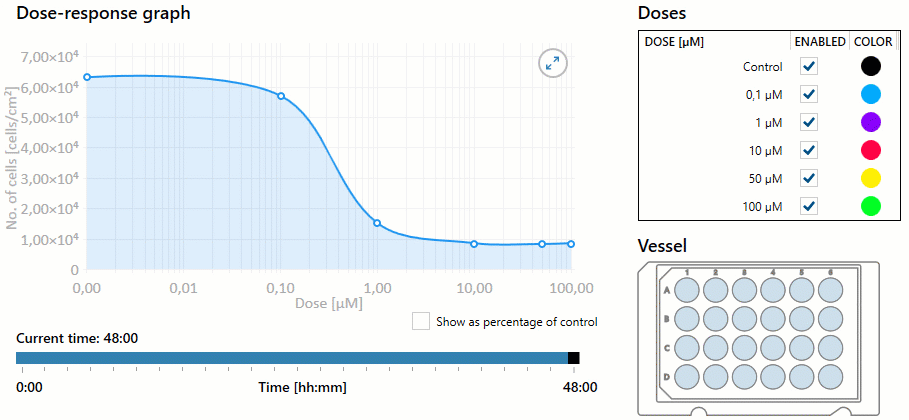1.9 Efficacy, Dose-Response, Onset, Peak, and Duration
Dosing considerations play an important role in understanding the effect that a medication may have on a client. During administration, the nurse must pay close attention to the desired effect and therapeutic response, as well as the safe dose range for any medication.
The nurse should have an understanding of medication efficacy in order to ensure its appropriateness. If a nurse is provided a variety of medication choices according to a provider’s written protocol, the nurse should select the option with the anticipated desired therapeutic response.
Additionally, the nurse must be aware of the overall dose-response based on the dosage selected. Dose response is the dose of medication required to achieve the desired response to the medication. As the dose increases, the response of the drug may increase, as well as the potential for toxicity. This response helps determine the therapeutic index of a drug, or the effective dose range. The measured response and dose are often graphed perpendicular to each other, with the slope of the graph’s curve representing therapeutic index (or overall dose-effect). It is important to note that some medications have a very small therapeutic window, and even small increases in dosages can result in toxic effects. See Figure 1.8[1] for an illustration of a dose-response graph.

Onset, Peak, and Duration
Three additional principles related to the effect a medication has on a client are onset, peak, and duration.
Onset of medication refers to when the medication first begins to take effect. Time of onset is affected by the route of administration. For example, a diuretic given intravenously will begin to take effect much faster than a diuretic administered orally because the intravenous route delivers the drug directly to the systemic circulation and avoids the first-pass effect.
Peak refers to the maximum concentration of medication in the body, and the client shows evidence of greatest therapeutic effect. For example, a client taking ibuprofen can anticipate maximum pain relief in one to two hours when the medication reaches peak serum levels.
Duration refers to the length of time the medication produces its desired therapeutic effect. For example, the duration of oral acetaminophen is four to six hours, at which time the client will likely require an additional dose for pain.
Duration, Dosing, and Steady State
Now let’s consider the implication of duration and dosing. Remember the duration of medication is correlated with the elimination. Half-life is the amount of time that it takes for half of the drug to be eliminated from the body.
If a medication has a short half-life (and is therefore eliminated more quickly from the body), the therapeutic effect is shorter. These medications may require repeated dosing throughout the day in order to achieve steady blood levels of active free drug and a sustained therapeutic effect.
Other medications have a longer half-life (and therefore are eliminated more slowly from the body, resulting in longer therapeutic duration) and may only be administered once or twice per day. For example, oxycodone immediate release is prescribed every 4 to 6 hours for the therapeutic effect of immediate relief of severe pain, whereas oxycodone ER (extended release) is prescribed every 12 hours for the therapeutic effect of sustained relief of severe pain.
Steady state refers to the point at which the amount of drug entering the body is equal to the amount of drug being eliminated, resulting in a stable drug concentration.[2] When steady state is achieved, there is a state of equilibrium in the body and the concentration of the drug remains constant, resulting in optimal therapeutic effect.
Clinical Example
Consider this client care example and apply the principles of onset, peak, and duration: A 67-year-old female postoperative client rings the call light to request medication for pain related to the hip replacement procedure she had earlier that day. She notes her pain is “excruciating, a definite 9 out of 10.” Her brow is furrowed, and she is grimacing in obvious discomfort. As the nurse providing care for the client, you examine her postoperative medication orders and consider the pain medication options available to you. In reviewing the various options, it is important to consider how quickly a medication will work (onset), when the medication will reach maximum effectiveness (peak), and how long the pain relief will last (duration). Understanding these principles is important in effectively relieving the client’s pain and constructing an overall plan of care.
Critical Thinking Activity 1.9
- At 0500, your client who had a total knee replacement yesterday rates his pain while walking as 7 out of 10. Physical therapy is scheduled at 0900. The client has acetaminophen (Tylenol) 625 mg ordered every four hours as needed for discomfort. What should you consider in relation to the administration and timing of the client’s pain medication?
- Your client is prescribed NPH insulin to be given at breakfast and supper. As a student nurse, you know that insulin is used to decrease blood sugar levels in clients with diabetes mellitus. During report, you hear that the client has been ill with GI upset during the night, and the nursing assistant just informed you he refused his breakfast tray. While reviewing this medication order, you consider the purpose of the medication and information related to the medication’s onset, peak, and duration. When reviewing the drug reference, you find the NPH insulin has an onset of about 1 – 3 hours after medication administration. What should you consider in relation to the administration and timing of the client’s insulin?
Note: Answers to the Critical Thinking activities can be found in the “Answer Key” section at the end of the book.
- "Interactive_dose-response_curve.gif" by Egelberg is licensed under CC BY-SA 4.0 ↵
- This work is a derivative of StatPearls by Wadhwa and Cascella and is licensed under CC BY 4.0 ↵
The maximum effect of which the drug is capable.
The dose of medication required to achieve the desired response to the medication.
When a medication first begins to work.
When the maximum concentration of drug is in the body.
The length of time that a medication is available within the body and producing its desired therapeutic effect.
The point at which the amount of drug entering the body is equal to the amount of drug being eliminated, resulting in a stable drug concentration.

